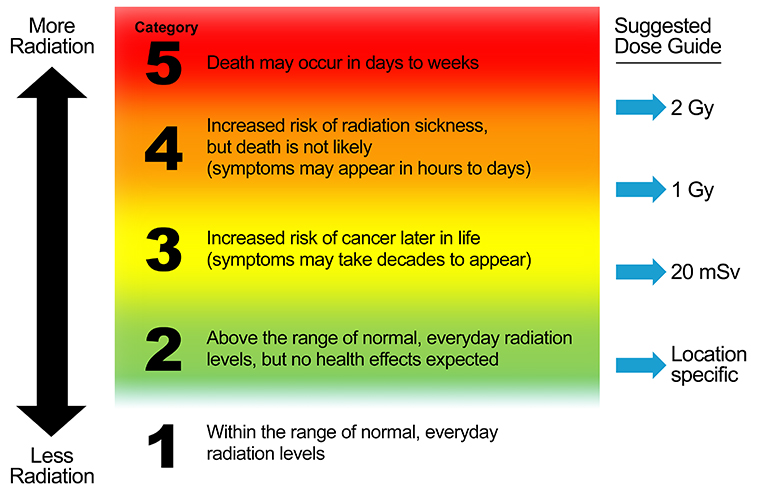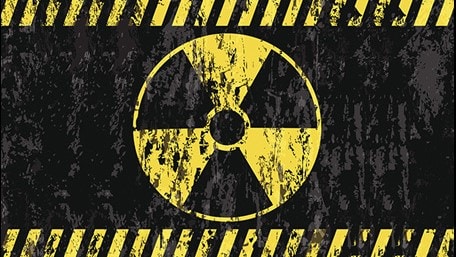From: "=?US-ASCII?Q?Centers_for_Disease_Control_and_Preve... [Edit Address Book]
To: flutrackers@earthlink.net
Subject: Radiation Hazard Scale
Date: Feb 7, 2017 3:06 PM
Radiation Hazard Scale
A Tool for Communication in Nuclear and Radiological Emergencies
The Centers for Disease Control and Prevention has developed the Radiation Hazard Scale as a tool for communication in emergencies.
This tool:
- Provides a frame of reference for relative hazards of radiation.
- Conveys meaning without using radiation measurements or units that are unfamiliar to people.
- Is designed for use only in radiation emergencies and is applicable for short-term exposure durations, for example, over a period of several days.
- Is best used when accompanied with protective action recommendations or instructions.
- Has been audience tested with public information officers, emergency management and public health professionals, and members of the public.

Description of the Radiation Hazard Scale Categories
| Category |
Description |
| 5 | Category 5 means that radiation doses are dangerously high and potentially lethal. High doses of radiation can cause massive damage to organs of the body and kill the person. The exposed person loses white blood cells and the ability to fight infections. Diarrhea and vomiting are likely. Medical treatment can help, but the condition may still be fatal in spite of treatment. At extremely high doses of radiation, the person may lose consciousness and die within hours. For more information, see https://www.remm.nlm.gov/ars_summary.htm |
| 4 | Category 4 means that radiation doses are dangerously high and can make people seriously ill. Radiation doses are not high enough to cause death, but one or more symptoms of radiation sickness may appear. Radiation sickness, also known as Acute Radiation Syndrome (ARS), is caused by a high dose of radiation. The severity of illness depends on the amount (or dose) of radiation. The earliest symptoms may include nausea, fatigue, vomiting, and diarrhea. Symptoms such as hair loss or skin burns may appear in weeks. For more information about the health effects of radiation, see http://emergency.cdc.gov/radiation/healtheffects.asp For more information about medical treatment of radiation exposure, see http://emergency.cdc.gov/radiation/countermeasures.asp |
| 3 | Category 3 means that radiation doses are becoming high enough where we may expect increased risk of cancer in the years ahead for people who are exposed. Leukemia and thyroid cancers can appear in as few as 5 years after exposure. Other types of cancer can take decades to develop. Studies have shown that radiation exposure can increase the risk of people developing cancer. This increased risk of cancer is typically a fraction of one percent. The lifetime risk of cancer for the population due to natural causes is approximately 40%. The increase in risk of cancer from radiation depends on the amount (or dose) of radiation, and it becomes vanishingly small and near zero at low doses of radiation. For more information, see http://emergency.cdc.gov/radiation/cancer.asp |
| 2 | Category 2 means that radiation levels in the environment are higher than the natural background radiation for that geographic area. However, these radiation levels are still too low to observe any health effects. When radiation levels are higher than what we normally have in our natural environment, it does not necessarily mean that it will cause us harm. For more information about health effects of radiation, see http://www.cdc.gov/nceh/radiation/health.html |
| 1 | Category 1 means that radiation levels in the environment are within the range of natural background radiation for that geographic area. Low amounts of radioactive materials exist naturally in our environment, food, air, water, and consequently in our bodies. We are also exposed to radiation from space that reaches the surface of the Earth. These conditions are natural, and this radiation is called the natural background radiation. For more information about radiation and radioactivity in everyday life and how it can vary by location, see http://www.cdc.gov/nceh/radiation/sources.html |
Suggested Guide on How to Assign Radiation Hazard Categories
The Radiation Hazard Scale is intended to communicate relative hazards to populations under emergency conditions when exact radiation exposure parameters for specific individuals are not available. Note that:
- There are no sharp lines separating radiation hazard categories.
- Transition from Category 1 to Category 2 depends on the range of natural background radiation for a geographic area.
- The radiation dose values are whole-body doses and are suggested guides for radiation protection purposes. Dose values are meant to be used by radiation protection experts and emergency response or public health authorities. For a description of radiation units listed in the dose guide, see Primer on Radiation Measurements.
- Radiation dose values are not meant to be included in public messaging, especially during early phase of a radiation emergency.

Example Uses of Radiation Hazard Scale in Emergency Communication Messages
Examples after a nuclear detonation:
- In areas where the Radiation Hazard Category is 5, sheltering in place can help maintain a Category 2 or 3 until instructed to evacuate. In contrast, self-directed evacuation in fallout areas can place a person at Category 4 or 5.
- If people are contaminated with nuclear fallout, self-decontamination can rapidly decrease radiation hazard from Category 5 to Category 2 or 1.
Example Uses of Radiation Hazard Scale in Displaying Environmental Data
Select a scenario:
- Detonation of an Improvised Nuclear Device (IND) ? Download PDF
- Accidental release from a nuclear power plant (NPP) ? Download PDF
- Explosion of a Radiological Dispersal Device (RDD) ? Download PDF
Frequently Asked Questions
What is the difference between the International Nuclear Event Scale (INES) and the Radiation Hazard Scale?
These two scales have quite different applications in an emergency. The INES, developed by the International Atomic Energy Agency is a tool to grade the safety significance of a particular event associated with sources of ionizing radiation. The INES describes the accident itself. On the other hand, the Radiation Hazard Scale describes the immediate potential impact of the accident for people, and the hazard category depends on where people are located.
For example, the severity of the March 2011 accident at the Fukushima Daiichi nuclear power plant has been given the highest rating of 7 on the INES scale. Regardless of whether we live in the United States or Japan, the INES rating for the Fukushima Daiichi accident is 7. However, the Radiation Hazard Category would have been quite different for people depending on their location. For emergency responders working at the Fukushima Daiichi plant at the time of the accident, the Radiation Hazard Category was 4 or 5 depending on where they worked at the plant. At the same time, the Radiation Hazard Category for people living in Tokyo was 2 for a short period of time, and it was Category 1 for people in the United States.
Can the radiation hazard scale be used to describe medical exposures?
No. In its present form, this Scale is intended only for emergency exposure situations.
Would the public need pre-event education on interpreting the scale?
While pre-event education is always helpful, there is no requirement for pre-event public education for effective use of this Scale. Our audience testing with members of the public who had at least a high school diploma indicated that the Scale is simple enough to understand, and it can be described briefly by a Public Information Officer or a news reporter.
Who would assign the radiation hazard categories in an emergency?
Environmental scientists and radiation safety experts can evaluate the data and assign the Radiation Hazard Categories in coordination with emergency management authorities, public health officials, and communication experts.
- Page last reviewed: December 7, 2016
- Page last updated: December 13, 2016
